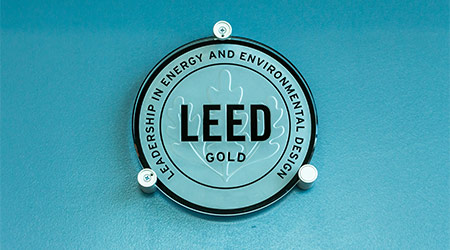LEED Safety First Credits: Battling Coronavirus Sustainably
Guidance for indoor air quality, enhanced cleaning, and reentry strategies highlight the LEED Safety First suite of pilot credits.
LEED is arguably the most recognizable rating system for buildings, and it has taken on virus mitigation and building re-entry head on with a series of pilot credits called Safety First.
“About a year ago, we realized we needed special strategies tailored to the pandemic,” says Larissa Oaks, indoor environmental quality specialist for the U.S. Green Building Council. “For facility managers and owners, these Safety First pilot credits build on existing LEED strategies, providing guidance on responding to challenges of the pandemic.”
Pilot credits are something USGBC uses frequently to test out new strategies it may add to its signature LEED rating systems for design and construction, operations and maintenance, interior design and construction, cities and communities, and others. But these seven credits are specifically focused on the coronavirus, drawn from the most current science and evidence.
One credit, for example, requires users to create and execute an enhanced cleaning and disinfection plan for their space. While of course cleaning and disinfection is not new — there are a whole series of LEED credits for green cleaning — this particular credit asks users to select disinfectants from EPA’s approved list for use against COVID-19, among other enhanced strategies.
“This credit especially builds on top of the existing cleaning credits,” says Oaks. “Facility managers can take existing cleaning policies and expand them. They can add useful product training into existing policies, so it’s really improving your cleaning.”
A crucial part of this pilot credit is also measuring the effectiveness of the cleaning program.
“Specifically for cleaning, we added requirements for evaluating cleanliness of surfaces,” says Oaks. “If you’re really interested in understanding the effectiveness of green cleaning, that requirement will be helpful. And it will also help with cost and resource management because the goal is to identify where more or less cleaning is necessary. You optimize cleaning locations and frequencies.”
Measuring progress is one of the keys to ensuring success of any initiative, but especially how effective coronavirus mitigation strategies are. Facility managers know they can’t just throw money at a problem and expect everything to be fine.
Another Safety First credit — Managing Indoor Air Quality During COVID-19 — has a similar measuring and monitoring goal, and also aligns with best practices for good air quality for COVID and beyond. The credit builds on existing LEED air quality standards to increase ventilation and air filtration, and design measures of physical distancing.
The Safety First credits also include a strategy called Arc Re-entry that helps build on existing measuring and monitoring plans to manage the risk of infection and disease transmission. Arc is the platform LEED users employ to manage and track their data, including energy, water, indoor air quality, occupant satisfaction, and more. So by using Arc for managing building reopening and reentry plans with this Safety First pilot credit, users are already well on their way to a good data monitoring initiative. And also to LEED.
“Arc is the perfect on-ramp to LEED,” says Oaks. Because Arc is all about data, it can cover the gamut of strategies to measure and analyze any and all data points facility managers want. The Safety First credit “guides teams on how to better benchmark and track disease-related data.”
Related Topics:















